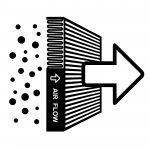Pulse Tools Performance – It’s in the air

A stable air pressure is more important than a high pressure.
The general recommendation is to supply 6.3 bar of dynamic pressure to the tool. Dynamic pressure is a measurement taken at air regulator when it is running with no load.
There are cases where the air installation is not dimensioned to provide suitable pressure or the tool may be situated at the end of an air network with lower pressure. Sometimes, if the pressure is too low and the tool cannot reach the required torque, it may be necessary to use a larger tool for the application.
In these cases, it is important to keep in mind that a stable pressure is more important than a high pressure. Without stable pressure to the tool, the output torque will scatter and the joint’s quality may be compromised.
Since most applications using pulse tools are quality critical, the torque accurac y is a key factor, but air pressure fluctuations and their impact are often overlooked.
y is a key factor, but air pressure fluctuations and their impact are often overlooked.
All pulse tools are subject to increased torque scatter if air pressure is unstable, but depending on the technology employed to shut the tool off, they can be more or less robust.
Fuji shut-off FLT pulse tools use the oil pressure in the pulse unit to trigger shut-off, which results in more stable performance when there are moderate air pressure variations. This brings better results than technologies using the pulse unit’s inertia.
Different air pressures dramatically change the pulse tool’s performance and different pulse tool technologies have varying operating ranges. As an example – the Fuji FLT-series operates between 5-6.3 bars while the Fuji FPT series operates between 5-6.3 bars.
3 effects of a lower air pressure on a pulse tool:
- Lower tool max torque. The catalogue values for most manufacturers, including Fuji, represent torques at 6.3 bar.
- (Generally) Improved torque scatter / accuracy, due to more pulses.
- More pulses lead to longer cycle times and more tool wear.
For a tool rated at 6.3 bar, having a higher inlet pressure will increase torque scatter and also make the tool wear out faster. Using a higher air pressure is not recommended and will not increase the performance of your pulse tool.
Using a regulator will ensure a stable pressure for the tool.
In order to ensure stable pressure, it is key to add a regulator to the air drop in order to set the pressure at a level that can be sustained at all times. The ideal case is to have 7-8 bars of available pressure at the regulator to have the most freedom in setting up the tool. Having excess pressure available means that the regulator can be set as high or as low as the application requires.
Our advice: Try to allow the regulator to be set at 0.5-1 bar below maximum available pressure in order to prevent any pressure fluctuations on the main air line from affecting the tool.
Impure air can quickly destroy the air motor of your pulse tool
Another environmental risk is impurities in the air.  Dirt or large amounts of water in the compressed air can quickly destroy the air motor, resulting in tool breakdown and costly repairs. For the air network overall, having sufficient drying capacity is important, but for each pulse tool, a filter and a lubricator should be installed.
Dirt or large amounts of water in the compressed air can quickly destroy the air motor, resulting in tool breakdown and costly repairs. For the air network overall, having sufficient drying capacity is important, but for each pulse tool, a filter and a lubricator should be installed.
The air filter will prevent particles from entering the tool and the lubricator will ensure the motor stays oiled and running smoothly.